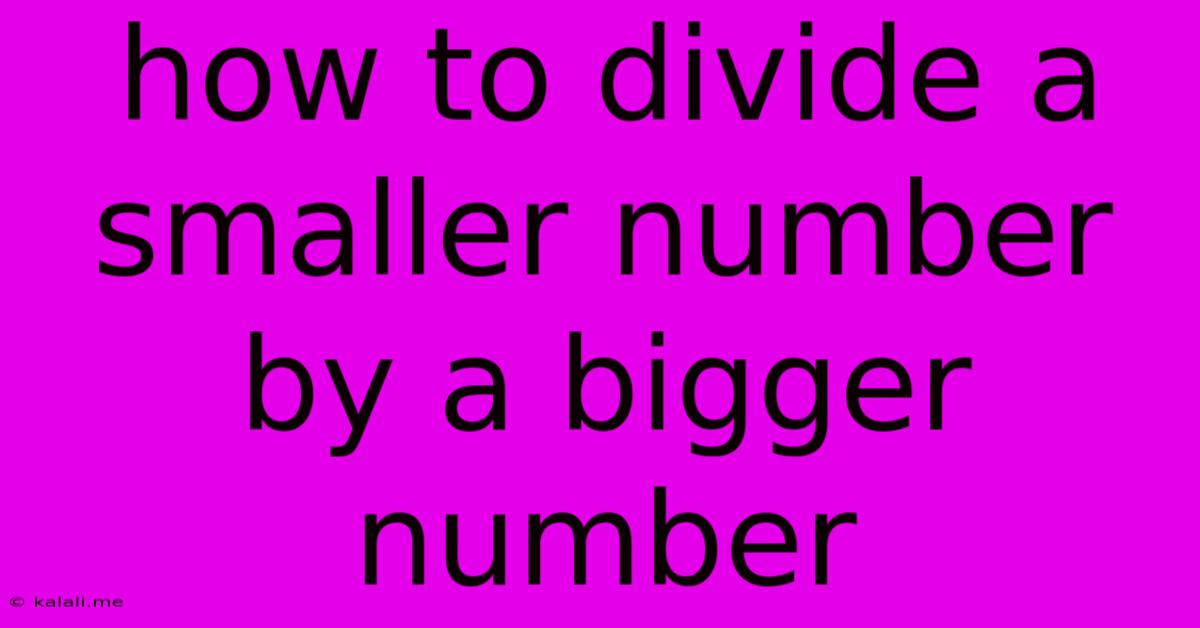How To Divide A Smaller Number By A Bigger Number
Kalali
May 22, 2025 · 3 min read

Table of Contents
How to Divide a Smaller Number by a Larger Number: A Simple Guide
Dividing a smaller number by a larger number might seem daunting at first, but it's a straightforward process with a predictable result: a decimal number less than 1. This guide will walk you through the steps, explaining the concept and providing examples to solidify your understanding. Understanding this concept is crucial for various applications, from calculating percentages to solving complex mathematical problems. This article will cover the methods using long division and understanding the resulting decimal value.
Understanding the Concept
When you divide a smaller number (the dividend) by a larger number (the divisor), you're essentially asking, "How many times does the larger number fit into the smaller number?" Since the larger number won't fit into the smaller number a whole number of times, the answer will be a fraction, which we represent as a decimal. The result will always be less than 1.
Method 1: Long Division
Long division is a classic method for tackling this type of problem. Let's illustrate with an example:
Example: Divide 3 by 5 (3 ÷ 5)
-
Set up the long division:
____ 5 | 3.00 -
Add a decimal point and zeros: Since 5 doesn't go into 3, we add a decimal point to the dividend (3) and add zeros as needed. This doesn't change the value of the number.
-
Divide: How many times does 5 go into 30? It goes in 6 times (5 x 6 = 30).
0.6 5 | 3.00 3.0 --- 0 -
The result: The answer is 0.6. This means 3 is 60% of 5.
Method 2: Using Fractions
Another way to approach this is by expressing the division as a fraction:
Example: Divide 2 by 7 (2 ÷ 7)
-
Write as a fraction: The division 2 ÷ 7 can be written as the fraction 2/7.
-
Convert to decimal: To convert this fraction to a decimal, divide the numerator (2) by the denominator (7) using long division, as shown in Method 1. You'll find that 2/7 ≈ 0.2857.
This method provides the same result and enhances the understanding of the relationship between fractions and decimals.
Understanding the Decimal Result
The decimal result represents a part of a whole. In our examples, 0.6 represents six-tenths and 0.2857 represents approximately twenty-eight and a half hundredths. The further you continue the long division, the more precise your decimal answer becomes.
Practical Applications
Understanding how to divide smaller numbers by larger numbers is crucial in many real-world scenarios:
- Calculating Percentages: Finding what percentage one number is of another often involves this type of division.
- Scaling and Ratios: Adjusting recipes or working with proportions frequently requires dividing smaller quantities by larger ones.
- Data Analysis: Many statistical calculations rely on understanding relative proportions and ratios.
By mastering this fundamental mathematical concept, you'll improve your problem-solving abilities and broaden your understanding of numbers and their relationships. Remember to practice regularly to build confidence and proficiency.
Latest Posts
Latest Posts
-
How To Say Be Nice In Spanish
May 22, 2025
-
Firex Smoke Alarm Keeps Going Off
May 22, 2025
-
Can Induction Pots Be Used On Gas
May 22, 2025
-
How To Stop Water Trickling Into Toilet Bowl
May 22, 2025
-
What Is Headless Mode On A Drone
May 22, 2025
Related Post
Thank you for visiting our website which covers about How To Divide A Smaller Number By A Bigger Number . We hope the information provided has been useful to you. Feel free to contact us if you have any questions or need further assistance. See you next time and don't miss to bookmark.